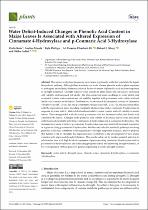| dc.contributor.author | Kolo, Zintle | |
| dc.contributor.author | Majola, Anelisa | |
| dc.contributor.author | Phillips, Kyle | |
| dc.date.accessioned | 2023-03-22T09:42:36Z | |
| dc.date.available | 2023-03-22T09:42:36Z | |
| dc.date.issued | 2023 | |
| dc.identifier.citation | Zintle K. et al. (2023). Water deficit-induced changes in phenolic acid content in maize leaves is associated with altered expression of cinnamate 4-hydroxylase and p-coumaric acid 3-hydroxylase.Plants, 12(1), 101. https://doi.org/10.3390/plants12010101 | en_US |
| dc.identifier.uri | DOI: 10.3390/plants12010101 | |
| dc.identifier.uri | http://hdl.handle.net/10566/8633 | |
| dc.description.abstract | The amino acid phenylalanine is a precursor to phenolic acids that constitute the lignin biosynthetic pathway. Although there is evidence of a role of some phenolic acids in plant responses to pathogens and salinity, characterization of the involvement of phenolic acids in plant responses to drought is limited. Drought reduces water content in plant tissue and can lead to decreased cell viability and increased cell death. We thus subjected maize seedlings to water deficit and evaluated relative water content and cell viability together with p-coumaric acid, caffeic acid and ferulic acid contents in the leaves. Furthermore, we measured the enzymatic activity of cinnamate 4-hydroxylase (EC 1.14.13.11) and p-coumarate 3-hydroxylase (EC 1.14.17.2) and associated these with the expression of genes encoding cinnamate 4-hydroxylase and p-coumarate-3 hydroxylase in response to water deficit. Water deficit reduced relative water content and cell viability in maize leaves. This corresponded with decreased p-coumaric acid but increased caffeic and ferulic acid content in the leaves. Changes in the phenolic acid content of the maize leaves were associated with increased enzymatic activities of cinnamate 4-hydroxylase and p-coumarate hydroxylase. The increased enzymatic activity of p-coumarate 3-hydroxylase was associated with increased expression of a gene encoding p-coumarate 3-hydroxylase. We thus conclude that metabolic pathways involving phenolic acids may contribute to the regulation of drought responses in maize, and we propose that further work to elucidate this regulation may contribute to the development of new maize varieties with improved drought tolerance. This can be achieved by marker-assisted selection to select maize lines with high levels of expression of genes encoding cinnamate 4-hydroxylase and/or p-coumarate 3-hydroxylase for use in breeding programs aimed and improving drought tolerance, or by overexpression of these genes via genetic engineering to confer drought tolerance. | en_US |
| dc.publisher | MDPI | en_US |
| dc.subject | Water deficit | en_US |
| dc.subject | Drought stress | en_US |
| dc.subject | Phenolic acids | en_US |
| dc.subject | Biotechnology | en_US |
| dc.subject | Plant | en_US |
| dc.title | Water deficit-induced changes in phenolic acid content in maize leaves is associated with altered expression of cinnamate 4-hydroxylase and p-coumaric acid 3-hydroxylase | en_US |
| dc.type | Article | en_US |

